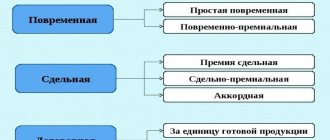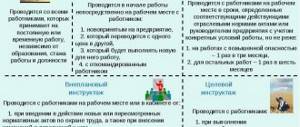- Obtain written confirmation from all employees that they agree to this transition. This is not necessary only in two cases, if the point system of remuneration is established at the enterprise as the first payment system, or if further use of the old system is impossible due to a change in organization at the enterprise, or if the technological working conditions of employees have changed. This is stated in Art. 74 Labor Code of the Russian Federation.
- Approve the draft local act, which was developed by the circle of employees established by the manager.
- Introduce all employees of the enterprise to the new project. This is stated in Art. 22 Labor Code of the Russian Federation.
The concept of a point system for calculating salaries
The system is an organization of salary payment without tariffication. The amount is calculated in proportion to the contribution made by each employee to the common cause. A worker’s salary is directly dependent on the volume of his participation in the work process. Such participation is measured by points. Their quantity contributes to the accurate calculation of wages.
An employee can receive points if he meets a number of requirements in accordance with Art. 132 Labor Code of the Russian Federation:
- presence of certain qualifications;
- complexity of the work performed;
- the total volume of labor produced;
- quality of work.
To correctly assign points, it is recommended to use generally accepted calculation methods. Thus, qualifications are calculated according to two characteristics - work experience in this field and knowledge acquired during specialized studies. Training can take place during the tenure of the position; based on its results, the salary level should change.
There are no common criteria used by everyone to assess the complexity of work. Each employer resolves this issue independently. Usually the specifics of the enterprise, harmfulness, and the impact of working conditions on the health of employees are taken into account.
The most difficult thing is to evaluate the quality of work. The consideration must be carried out from the perspective of compliance with several requirements. For example, according to the number of defects or complaints received, the obligation to politely communicate with consumers and clients.
When to use
The commented remuneration system is actively used in government institutions - schools, kindergartens, clinics. The implementation is also taking place in private enterprises. Compliance with modern realities and trends in the management sphere is considered the main goal of introducing a new system.
A strong connection is established between the amount of payments and the employee’s performance. This allows for the selection of the most effective and efficient personnel at the state level.
The Ministry of Health and Social Development believes that high-quality provision of services in the public sector is one of the main ways of development. Therefore, the dependence of the salaries of managers on the average earnings of employees at the enterprise is established. This measure arouses the interest of managers in the quality work of staff and commensurate payment.
Payment procedure
Employers often have difficulty determining the amount of salary for people occupying the same positions. Letter No. 111-6-1 published by Rostrud recorded the requirement to establish an equivalent salary for individuals serving in the same position. That is, the salary for these people should be equal.
In such a situation, the manager should fix equal salaries. But the points received by the employee should be issued in the form of bonus funds. The level of additional payment for each employee will vary depending on qualifications, quality of work, and complexity of the work.
Can they refuse to give out the reward they have earned?
The Regulations must specify cases when the incentive bonus can be canceled or its amount reduced.
What can cause you to lose your incentive payment?
- Failure to comply with safety regulations.
- Failure to comply with internal regulations.
- Violation of production discipline.
- Failure to fulfill one's official duties.
- Third Party Complaints.
- Poor quality work.
- Damage to the organization's property.
Incentive payments can be a significant increase in the salary of an employee of a budget organization. You just need to take a responsible approach to your work and constantly improve your professionalism, receiving the necessary points for self-development.
Payment calculation example
A clear example of the use of a point system is the remuneration of health workers. Doctors and other medical staff, in addition to their regular salaries, receive additional material resources for night shifts, overtime, and overtime. In the budgetary sphere, there are certain specifics in calculating the volume of payments.
To accurately determine an employee’s salary, it is necessary to calculate:
- The number of points scored by an employee for a specific period of time. The calculation is made using a special table.
- The total number of points for the entire company or institution.
- How much will be allocated to workers' salaries?
- Individual payment amount for each employee.
Thus, clinic No. 5 in Omsk scored a total of 150 points. The salary fund is limited to 150,000. Nurse Smirnova scored 10 points. Nurse's salary=10/150×150000=10 thousand rubles.
Pros and cons of the point system
Among the key advantages of the system are:
- It is excellent when used in calculations to evaluate the work of a team working in the service sector, without taking into account the number of goods or products produced in the calculations. For example, a law firm, a consulting firm, an accounting organization.
- Independent choice of scoring criteria. This allows us to determine the optimal characteristics for a particular enterprise, taking into account its specific type of activity. For example, a large records management firm may consider the quantity and timely submission of documentation when making accruals. Small institutions can focus on the correctness of the documents drawn up.
- It is considered an ideal concept when calculating bonus payments in small companies and institutions.
The disadvantages of the system usually include:
- the amount of payments will not be constant. The employee will not have the opportunity to count on a specific amount, since it will be transformed each pay period;
- not an easy concept to use. Each period when it is necessary to pay wages, you will need to again evaluate the quality of the employee’s work and other criteria, and withdraw a new amount. Such actions will be a big burden for the accounting department (especially in a large organization);
- frequent conflict situations between workers regarding the amount of funds received. The basis for the quarrels are the criteria by which the quality of work was taken into account.
Thus, the choice of ways to stimulate employees remains with the head of the organization (with the exception of budgetary institutions).
Balanced scorecard to increase motivation and stimulate employees
Mitskevich Andrey Alekseevich - head of the INES consulting bureau, candidate of economic sciences, associate professor at the Higher School of Financial Management of the Academy of Economy under the Government of the Russian Federation.
A person cannot be controlled by direct influence.
Source: www.inesnet.ru/magazine/
A balanced system of increasing motivation (SMS) is an original development in the field of employee incentives, based on the spirit, but not the letter [1].
It would be more accurate to call it a balanced system of material incentives for workers, since moral encouragement is not considered in a balanced system of increasing motivation. Increasing moral motivation is more of an art than a science, while material incentives for workers, on the contrary, are based on the canons of economic and managerial rationality.
How to enter a point system
To start using the point system in an organization, you will need to perform a number of sequential actions, fixed in labor legislation and following the necessary requirements:
- The head of the enterprise or a person vested with all relevant functions is authorized to introduce the concept. He decides to transfer the material motivation of employees to a new method in accordance with Art. 135 Labor Code of the Russian Federation. Next, it determines the circle of persons who are responsible for creating an internal regulatory legal act.
- Responsible employees begin developing a local act.
- The developed project is submitted to the competent authorities for consideration. In accordance with Art. 372 of the Labor Code of the Russian Federation, the latter need to come to a general conclusion and give an answer within 5 days after receiving the document.
- A trade union or a representative of an organization has the right to make either a positive or negative decision on the analysis of the project. If the inspection agency makes a negative decision, then the manager has 3 days left to resolve any disagreements and disputes that have arisen.
Legislative framework
The modern Labor Code of the Russian Federation provides only a minimum set of rights and guarantees to employees. The participants in labor relations themselves can supplement this minimum.
This becomes possible through a combination of methods of state, contractual and local regulatory regulation. This is stated in Article 9 of the Labor Code of the Russian Federation, which states that the regulation of labor relations is carried out through the conclusion of labor agreements and collective agreements. In Art. 8 of the Labor Code of the Russian Federation, the legislator provided for the right of the employer to create local acts.
When creating your own documents, you must take into account that they must meet two conditions:
- do not contradict the norms of Russian legislation;
- not create less favorable working conditions for the employee compared to those provided for by the Labor Code of the Russian Federation.
Labor Code of the Russian Federation
Bonus and rating systems
The bonus concept is similar to the points concept. In this case, employees receive a permanent salary plus interest (bonuses) from the company’s total income. These funds are accrued to the employee in addition to his salary. This system fully complies with the established requirements of Rostrud.
The rating methodology is distinguished by greater stability of the amount of payments from the commented one. Recalculation is made only if one of the following circumstances exists:
- The employee's level of education has increased or decreased.
- The length of service in this field has changed.
- The position has changed to a higher or lower position.
The concept is based on the rating assigned to the worker, and not on the quality and quantity of work performed. The indicator varies depending on the employee’s level of education, position and length of service in a particular field. Designed for large firms and companies.
Allowances for education workers
Incentive payments help increase employee interest in teaching activities, as well as attract new personnel. In 2021, the amount of incentive bonuses can be up to 35% of wages.
What are the conditions for receiving payments for school teachers, teachers of technical schools and universities?
- Continuous professional development (completing special courses at least once every 3 years).
- The desire for self-development and self-education in order to improve professional qualities.
- Participation in conferences, seminars, teacher councils.
- Organization of exhibitions of student achievements.
- Conducting additional classes with capable students, as well as children from disadvantaged families.
- Preparing students for various competitions, olympiads, competitions.
- Conducting clubs and electives.
- Working with parents of students (involving them to participate in educational life, holding parent-teacher meetings, collaborating with the parent committee).
- Monitoring student progress.
- Organization of excursions, visits to creative and educational events.
The librarian has his own list of conditions for receiving an incentive bonus, which is established separately in each educational organization. Here are some points:
- library attendance by students;
- readability of library literature;
- maintaining catalogs of the literature fund in electronic format;
- organizing educational events for students;
- maintaining the library web page on the school website (if there is one);
- participation in professional competitions, seminars, etc.
Kindergarten workers can count on incentive payments if they not only take a responsible approach to their duties, but also apply new pedagogical developments, involve parents in participating in various kindergarten activities, and also help families who find themselves in difficult situations (for example, provide additional education with disabled children).
Features of the bonus concept
The effectiveness of the application of the methodology has been proven in companies engaged in production activities and engaged in the sale of goods and services. The employee should understand that the company's overall profit has a direct impact on his own income level. The system produces the desired results only if there is a close relationship between the incomes of management and workers.
A successful example of the implementation of the methodology is the transition of Russian Post to a bonus program since 2011. The system is valid for employees working in the sales department.
With the right choice of position, range of employee activities, salary amount and percentage value, the experience of applying the concept is effective.
The bonus payment system consists of:
- salary A constant amount of funds paid to the employee in any case, regardless of the profit of the enterprise and the results achieved;
- percent. Variable component, calculated based on the number of goods sold.
Receiving material resources in the form of interest allows you to significantly increase the employee’s income in the case of high sales and reduce it to a minimum in a situation where there is no trade.
A striking example of application is a company selling goods or services. Sellers receive cash for their “output” plus a percentage of each product sold.
Advantages and Disadvantages of Using the Bonus Concept
Salary is a key motivational factor for a worker. Therefore, when assigning payments and choosing a payment system, the manager must calculate all the pros and cons.
The positive aspects of the bonus method include:
- focus and interest of employees on results;
- low expenses for minimum established salaries for careless employees who do not strive to earn money;
- providing good wages to promising workers;
- renewal of the team by including ambitious, active, purposeful professionals.
This approach will not work for low-performing employees who are not willing to put in the time and effort to close as many deals as possible. For a constant salary increase, a specialist needs to work with full dedication every day.
The negative aspects of the concept are as follows:
- The lack of guarantees of receiving a regular, stable income does not allow you to apply for a housing loan or plan an expensive purchase.
- Rarely does the application of an interest rate not matter to a particular practitioner. Because the company’s income does not depend on his efforts alone.
- If there is a seasonality factor, then the rest of the time there is a risk of losing valuable employees. Or set an increased salary during a period of lack of demand for a product or service.
- The desire to increase sales sometimes fails because the product is uncompetitive and in little demand among buyers.
- The concept carries risks for both workers and employers. When choosing a technique, you should carefully weigh the pros and cons.
Forms of non-standard motivation in an organization
A sign of our time is a passion for everything new and unusual. You can see how effective creative thinking is; it is the engine of many life processes. The more creative a leader and his team are, the better results they can achieve .
Speaking about non-standard types of motivation, as an example, we can cite several successful finds.
- Unexpected presentation of a gift to the best employee. Send a thank you note via email.
- Sending a good employee on leave.
- Trust employees who have distinguished themselves with the most interesting and complex projects.
- Give employees the opportunity to independently choose projects and methods for solving assigned tasks.
- Reward the employee for not being sick. However, it is necessary to apply appropriate bonuses, for example, offering flu vaccinations at the company’s expense.
Methods that promote team unity and create a healthy moral and psychological atmosphere are also widely used. Company presentations that demonstrate the successes achieved through the diligence of team members are very effective.
Taking into account the results that different types of motivation can produce, we can conclude that they must be used in combination. To claim that one species has an advantage over another is a deep misconception. The main thing is to try to apply them taking into account the individual characteristics of individual employees, and to minimize the average approach.









